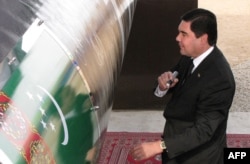Turkmen President Gurbanguly Berdymukhammedov and his government just cannot seem to get a break lately.
Not that they necessarily deserve it. But all the same, Turkmenistan's last realistic hope to export a significant amount of additional natural gas to a customer has just evaporated.
Line "D" of the Turkmenistan-China gas pipeline network was to be more than just the largest of four pipelines connecting western China to gas fields in Turkmenistan -- it also would have been the largest single gas pipeline connecting Turkmenistan to any consumer state.
Line D was supposed to carry some 30 billion cubic meters (bcm) of gas annually to China. The line took a different route. Lines A, B, and C all went from Turkmenistan through Uzbekistan and Kazakhstan before reaching China. To include all the Central Asian states, Beijing decided to route Line D through Uzbekistan, Tajikistan, and Kyrgyzstan, and then into China.
Already at the end of 2014, it was clear that there were problems in Kyrgyzstan and Tajikistan with forming joint ventures with Chinese companies to construct and later operate the pipeline, and some disagreements over the route.
Neither of those Central Asian countries was going to receive any gas from the line, but they would have taken in millions of dollars in transit fees.
At the end of 2016, RFE/RL's Kyrgyz Service, known locally as Azattyk, contacted an official in Kyrgyzstan involved with the project who said there had not been any meetings with Chinese officials about Line D since December 2015.
But it was Uzbekistan and China that appear to have officially put a halt to Line D; RIA Novosti reported on March 2 that China National Petroleum Corporation and Uzbekneftegaz had indefinitely postponed construction of the pipeline on Uzbekistan's territory.
Economic Crisis
This is a real blow to Turkmenistan. The country is experiencing the worst economic crisis in its 25-year history, in large part due to Turkmenistan's dependency on revenues from gas sales.
This is partly due to the drastic fall in gas prices in the last three years, but also due to Russia canceling its contract for Turkmen gas imports at the start of 2016 and the suspension of Turkmen gas supplies to Iran at the start of 2017 over a contract dispute.
That leaves Turkmenistan with only China as a customer. There are already three operating gas pipelines from Turkmenistan to China. Lines A and B can each carry 15 bcm and Line C can carry 25 bcm, for a combined 55 bcm of gas annually to China, though all the lines have not yet reached full capacity.
Since the three lines pass through Uzbekistan and Kazakhstan, also gas-producing countries, both of which have contracts to supply 10 bcm to the pipelines, though Kazakhstan has already signaled it wants to export more gas to China.
That leaves 35 bcm of space in the three lines for Turkmenistan.
It is always difficult to find reliable figures on Turkmenistan's gas industry, Turkmenistan is thought to have exported some 30 bcm of gas to China in 2016. If true, that means there is little extra room in the pipelines. With the postponement of Line D, Turkmenistan can expect to increase its gas exports no more than 5 bcm in the coming years.
The price China pays Turkmenistan for gas is said to around $185 per 1,000 cubic meters of gas, meaning if Turkmenistan does pump the extra 5 bcm of gas into the pipeline it would receive less than $1 billion annually for that. That would help, but it won't prop up Turkmenistan's sagging economy.
Price War?
It gets worse. China loaned Turkmenistan billions of dollars to develop Turkmen gas fields and build the pipelines to China, so some of the gas Turkmenistan ships to China goes toward paying off Ashgabat's debt.
Worse still, after Russia canceled its contract for Turkmen gas, Russian gas giant Gazprom renegotiated deals with Kazakhstan and Uzbekistan. According to a recent article in Russia's Life News, Gazprom reached a deal to pay Kazakhstan and Uzbekistan some $140 per 1,000 cubic meters. The article said Gazprom annulled the contract with Turkmenistan because Ashgabat was demanding $240 per 1,000 cubic meters.
So Turkmenistan faces the possibility of a price war with its Central Asian neighbors to supply gas to China.
Berdymukhammedov talks often about projects that will enrich Turkmenistan even further, such as the Turkmenistan-Afghanistan-Pakistan-India (TAPI) pipeline. That pipeline would carry 33 bcm of Turkmen gas. Turkmenistan says it has started construction of its segment of TAPI, though there has been no proof of this so far, and Pakistan claimed to have started its section in early March.
That leaves some 700 kilometers of Afghan territory between them, and the proposed route would run through areas where there is frequent and fierce fighting.
Berdymukhammedov has boldly predicted construction of TAPI would be completed in 2019, but Pakistan said at the end of January that it would be delayed by at least one year -- and even that estimate is likely very optimistic.
No one even talks about the Trans-Caspian Pipeline anymore. That was supposed to carry some 30 bcm of Turkmen gas west toward Europe.
Iran Reroutes Supplies
Turkmenistan probably just lost Iran as a customer. Winter is coming to an end, and Iranian officials have spent the weeks since the suspension of Turkmen gas supplies rerouting domestic electricity supplies. Construction of internal gas pipelines from southern Iran to areas in the north that were supplied by Turkmen gas has speeded up. Iran probably won't need Turkmen gas next winter.
So that leaves Turkmenistan with 35 bcm of space in the pipelines going to China, part of it going toward debt repayment.
There is no other gas-export project likely to be built within the next decade.
Quite a disappointment for Berdymukhammedov, who was boasting just a few years ago about exporting 180 bcm by 2030.








